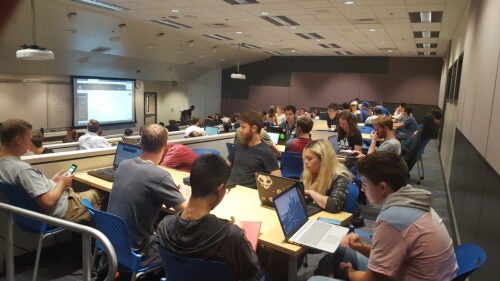
By Brittnee Earl
Over the last few years, the Center for Teaching and Learning, supported by funds from the National Science Foundation WIDER-PERSIST grant, has supported faculty, especially in STEM disciplines, to increase their use of evidence-based instructional practices (EBIPs) in their teaching. This has created a need for more classrooms that effectively support active learning. While many smaller classrooms at Boise State have been renovated to have a flexible structures and furnishings, there have not been any larger spaces (80 seats or more) conducive to active learning and group oriented work.
In fall 2017, the Center for Teaching and Learning, alongside the Provost’s Office, Campus Planning and Facilities, the Registrar’s Office and the Office of Information Technology, embarked on identifying a large enrollment classroom space to redesign from a lecture hall to an active learning classroom. With significant input from faculty in the Department of Physics, which has priority scheduling in MPCB 101, this classroom space now has a new look.
The room was designed to accommodate a variety of pedagogical choices while also maintaining a centralized focus for those who utilize traditional pedagogies. The remodeled classroom has a ground floor with three tiers and features movable tables and chairs. The new furniture offers flexibility and encourages peer-to-peer interaction. A large custom table at the front of the room supports interactive demonstrations.
In addition, there is now more space for students to work in teams, while enabling instructors to travel about the room while guiding students in active learning.
“I really like the set up,” said physics instructor Tiffany Watkins. “It makes getting around the room and interacting with groups in the center really easy. Before you had to fight your way into the center of the room.”
This sentiment is echoed by Scott Armentrout from the psychology department.
“This is such a wonderful classroom. I taught in this room last fall before the make-over. It is much easier to connect to students and to have great discussions.”
Other instructors are noticing increases in student engagement.
“The new layout is terrific. With the theater seating it was difficult to get the students to talk to each other. Now I am having trouble getting them to stop. I used to keep clicker questions open for 1 minute, but now I am having to stop them after a couple minutes because they are still discussing it,” noted James Brennan, physics.
“It has been, at least as of the first week, very easy to promote student discussion about clicker questions. I will be starting in-class exercises and worksheets next week, but I imagine that similar to the clickers it will be very easy to get students interacting and working together,” said Aaron Sup, physics.
Overall, faculty are pleased with classroom and its potential to support effective teaching and learning. As Liz Cook (English) stated, “I appreciate the investment put into this remodel. It sends a clear message to the students that we are committed to the quality of the classroom experience.”
It is hoped that the collaborative approach used for this classroom redesign can serve as a model for future efforts, where faculty input and considerations for effective teaching and learning are at the forefront of the design.